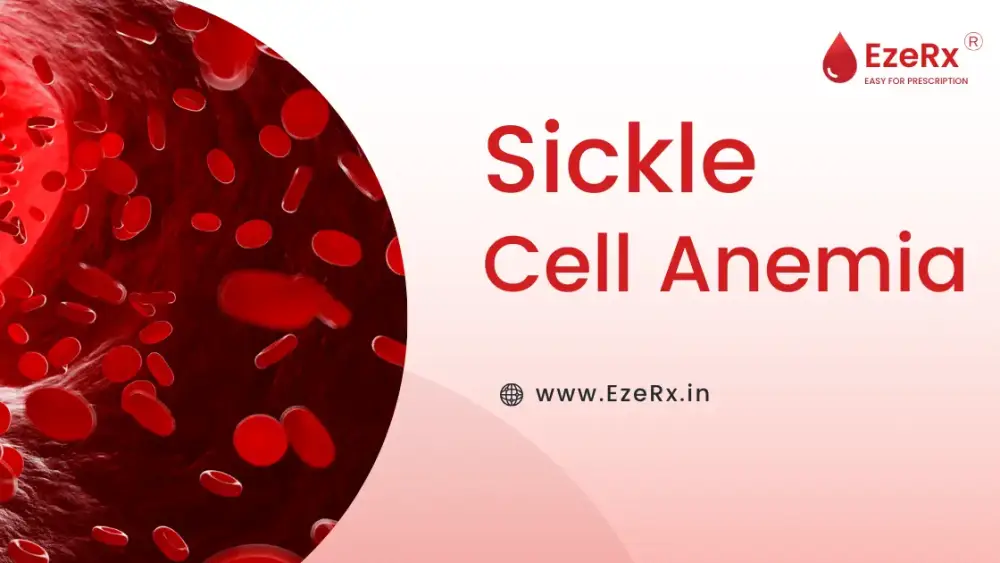
Sickle cell anemia, often referred to simply as sickle cell disease, is a hereditary condition that impacts the hemoglobin in red blood cells. This disease is characterized by abnormally shaped red blood cells that resemble a crescent or sickle, hence the name. In this blog, we will explore the underlying causes, common symptoms, and available treatments for sickle cell anemia.
Causes of Sickle Cell Anemia
Sickle cell anemia is primarily caused by a genetic mutation affecting hemoglobin, the protein responsible for carrying oxygen in red blood cells. Individuals with sickle cell disease inherit two abnormal hemoglobin genes, one from each parent. This inheritance leads to the production of abnormal hemoglobin known as hemoglobin S (HbS). When oxygen levels in the blood drop, these abnormal red blood cells become stiff and take on a characteristic sickle shape. This altered shape can cause a range of health problems.
.png)
Symptoms of Sickle Cell Anemia
Sickle cell anemia can manifest differently in each affected individual, but common symptoms and signs include:
- Pain Crises: Intense episodes of pain, often in the chest, joints, bones, and abdomen.
- Anemia Symptoms: Fatigue, weakness, and pale skin due to a decreased number of red blood cells.
- Jaundice: Yellowing of the skin and eyes due to the breakdown of red blood cells.
- Swelling of Hands and Feet: Known as dactylitis, this condition occurs primarily in infants.
- Frequent Infections: A weakened immune system can lead to frequent infections.
- Delayed Growth: In children, sickle cell disease can impact growth and development.
- Vision Problems: Damage to the retina can cause vision problems or even blindness.
Treatment for Sickle Cell Anemia
While there is currently no cure for sickle cell anemia, various treatment options aim to manage symptoms and improve the patient's quality of life. These treatments may include:
- Pain Management: Medications are prescribed to alleviate pain during sickle cell crises.
- Hydroxyurea: This medication can help reduce the frequency of pain crises.
- Blood Transfusions: In severe cases, regular blood transfusions may be necessary.
- Bone Marrow or Stem Cell Transplants: These procedures offer a potential cure but are complex and carry risks.
- Preventive Antibiotics: To reduce the risk of infections.
- Vaccinations: To protect against common infections.
- Pulmonary Hypertension Treatment: In cases where the disease affects the heart and lungs.
- Psychosocial Support: Mental health support can help patients cope with the challenges of living with sickle cell disease.
Complications and Long-Term Effects
Sickle cell anemia can lead to several complications and long-term effects, including:
- Organ Damage: The abnormal red blood cells can block blood flow to various organs, causing damage over time.
- Stroke: Reduced blood flow can lead to stroke, especially in children.
- Pregnancy Complications: Pregnant women with sickle cell disease may experience complications.
- Vision Loss: Blood vessel damage in the eyes can lead to vision problems.
- Leg Ulcers: Painful sores that develop on the legs.
- Gallstones: Increased breakdown of red blood cells can lead to gallstone formation.
Prevention and Management
Prevention strategies for sickle cell anemia primarily involve genetic counseling and prenatal testing for carriers. Managing the condition involves regular medical check-ups, adhering to prescribed treatments, and adopting a healthy lifestyle to minimize complications.
Conclusion
Sickle cell anemia is a challenging genetic disorder that affects individuals and families on a physical and emotional level. Understanding its causes, recognizing its symptoms, and exploring available treatments are crucial steps towards managing this condition effectively. While there is no one-size-fits-all solution, ongoing research and medical advancements offer hope for a better future for those living with sickle cell anemia. If you suspect you or a loved one may have sickle cell disease, it is essential to seek medical advice and support to ensure the best possible management and care.